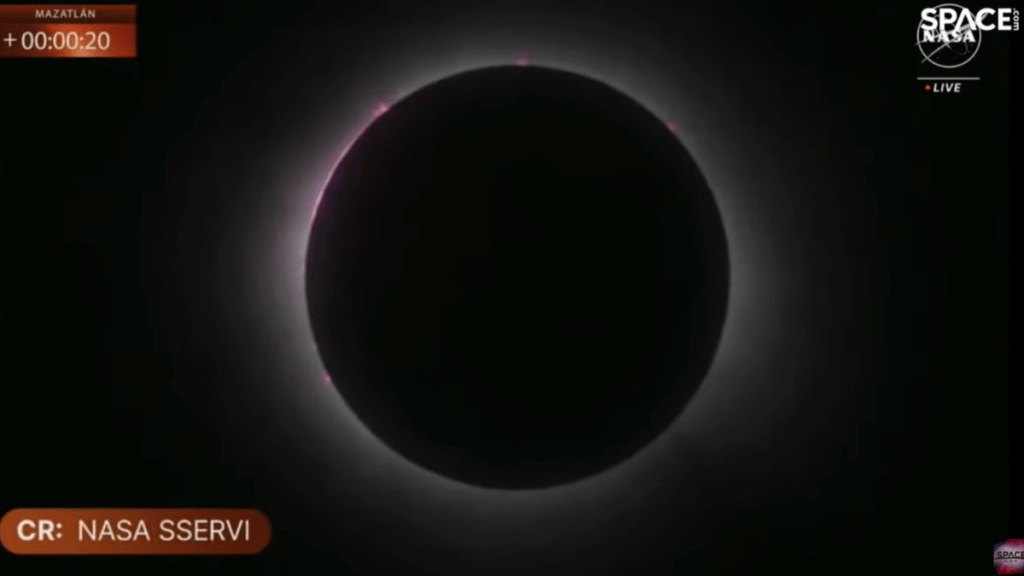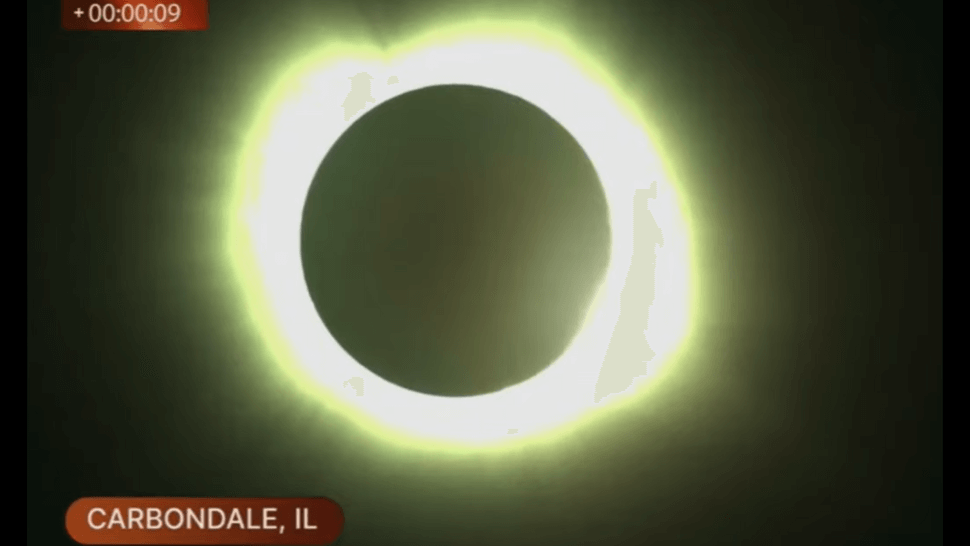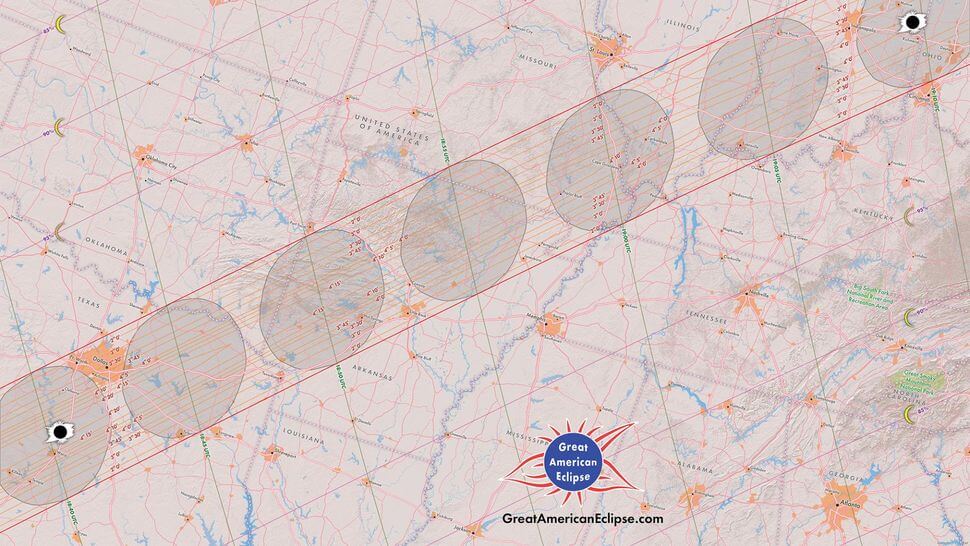
Total solar eclipse 2024 has begun and here are the first views! (Image Credit: Space.com)
It’s the moment eclipse-chasers have been waiting for. This year’s first solar eclipse has begun!
The total solar eclipse first made landfall in North America at Mazatlán in Sinaloa, Mexico, with the moon beginning to take its first “bite” out of the sun at 9:51 a.m. local time (12:51 p.m. EDT, 1651 GMT). Totality will begin in Sinaloa about one hour and 16 minutes later at 11:07 a.m. local time (2:07 p.m. EDT, 1807 GMT).
You can watch the total solar eclipse live here on Space.com. And keep up with all the actions with our total solar eclipse 2024 live updates blog.
All of North America and Central America will experience a partial solar eclipse today, but only those within the path of totality — an approximately 115-mile (185-kilometer) wide route through Mexico, 15 U.S. States, and Canada — will be able to see the moon entirely cover the sun’s disk.
One of the first locations to experience a partial solar eclipse was Pu‘uali‘i, Hawaii at 06:27 a.m. local time (12:27 p.m. EDT, 1627 GMT). But Pu‘uali‘i is not within the path of totality and will not experience the total solar eclipse.

Mazatlán experienced totality for approximately 4 minutes 20 seconds. From Mazatlán, the eclipse totality swept over Durango at 12:12 p.m. CST, to Torreón, then Coahuila, leaving Mexico at Piedras Negras, Coahuila, at around 1:27 p.m. CDT.
Residents of Kerrville, Texas, were the first citizens in the U.S. to see the totality at 1:32 p.m. CDT, which lasted for 4 minutes and 25 seconds. After passing over Texas, the path of totality moved over Oklahoma, with the moon totally covering the sun over Idabel, at 1:45 p.m. CDT.
“Cheers just erupted as the first stages of the eclipse began as most of the assembled children played on the park’s playgrounds, seemingly oblivious to the burgeoning spectacle above,” Brett Tingley said, describing the early moments of the eclipse in Wickliffe, KY.
| Location | Totality begins (local time) | Totality duration |
|---|---|---|
| Mazatlán, Sinaloa, Mexico | 11:07 a.m. MST | 4 minutes 20 seconds |
| Durango, Durango, Mexico | 12:12 p.m. CST | 3 minutes 50 seconds |
| Torreón, Coahuila, Mexico | 12:16 p.m. CST | 4 minutes 11 seconds |
| Piedras Negras, Coahuila, Mexico/Eagle Pass, Texas, U.S | 1:27 p.m. CDT | 4 minutes 24 seconds |
| Kerrville, Texas, U.S | 1:32 p.m. CDT | 4 minutes 25 seconds |
| Fredericksburg, Texas, U.S | 1:32 p.m CDT | 4 minutes 25 seconds |
| Dallas, Texas, U.S | 1:40 p.m. CDT | 3 minutes 52 seconds |
| Idabel, Oklahoma | U.S: 1:45 p.m CDT | 4 minutes 19 seconds |
| Russellville, Arkansas, U.S | 1:49 p.m. CDT | 4 minutes 12 seconds |
| Cape Girardeau, Missouri, U.S | 1:58 p.m. CDT | 4 minutes 7 seconds |
| Carbondale, Illinois, U.S | 1:59 p.m. CDT | 4 minutes 10 seconds |
| Bloomington, Indiana, U.S | 3:04 p.m. EDT | 4 minutes 3 seconds |
| Indianapolis, Indiana, U.S | 3:06 p.m. EDT | 3 minutes 51 seconds |
| Cleveland, Ohio, U.S | 3:13 p.m. EDT | 3 minutes 50 seconds |
| Erie, Pennsylvania | U.S: 3:16 p.m. EDT | 3 minutes 43 seconds |
| Rochester, New York, U.S | 3:20 p.m. EDT | 3 minutes 40 seconds |
| Montpelier, Vermont, U.S | 3:27 p.m. EDT | 1 minutes 42 seconds |
| Oakfield, Maine, U.S | 3:31 p.m. EDT | 3 minutes 23 seconds |
| Niagara Falls, Ontario, Canada | 3:18 p.m. EDT | 3 minutes 31 seconds |
| Montreal, Quebec, Canada | 3:26 p.m. EDT | 1 minute 57 seconds |
| Miramichi, New Brunswick, Canada | 4:34 p.m. ADT | 3 minutes 8 seconds |
| Tignish, Prince Edward Island, Canada | 4:35 p.m. ADT | 3 minutes 12 seconds |
| Catalina, Newfoundland, Canada | 5:13 p.m. NDT | 2 minutes 53 seconds |
The path of totality next reaches the state of Arkansas, then Missouri, on to Illinois, and then Indiana, Ohio, and Pennsylvania. The moon will completely cover the sun over Rochester, New York, for 3 minutes and 20 seconds at 3:20 p.m. EDT.
One of the last places to experience totality in the U.S. will be Oakfield, Maine, at 3:31 p.m. EDT. The completely eclipsed moon should make a spectacular sight over Niagara Falls in Ontario, Canada, at around 3:18 p.m. EDT.
The path of totality will sweep across Canada, with skywatchers in Catalina, Newfoundland, able to see the total eclipse of 2024 go out in style at around 5:13 p.m. NDT.

IMPORTANT NOTE: REMEMBER to NEVER look directly at the sun. You need to use solar filters to safely view the annular solar eclipse to avoid severe eye damage. Naked-eye observers will need to wear solar eclipse glasses, and if you are using cameras, telescopes or binoculars, they must have protective solar filters placed in front of their lenses at all times. Our how to observe the sun safely guide tells you everything you need to know about safe solar observations.





